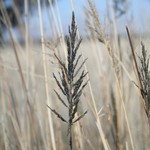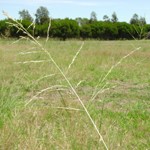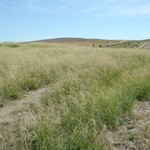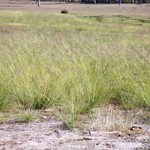African lovegrass
African lovegrass is a densely-tufted perennial grass.
Common name:
- African lovegrass
Scientific name:
- Eragrostis curvula (Schrad.) Nees
Plant status
Catchment management authority boundaries
Regionally controlled in in the North Central, Corangamite, Port Phillip and Western Port, Goulburn Broken, North East, West Gippsland and East Gippsland catchments.
Restricted in the Mallee, Wimmera and Glenelg Hopkins catchments.
Plant biology
Appearance
Herbaceous plant – Graminoid (grass, sedge or rush)

Description
African lovegrass is a densely-tufted perennial grass growing between 20 to 120cm high.
Stems
African lovegrass has slender, robust stems which are sometimes bent at the lower nodes.
Leaves
The leaves of African lovegrass are dark green to blue-green in colour. The blades are narrow, 3mm wide and 25 to 35cm long. They are narrowly tapered and often curl near the tips.
The leaf margins are often folded or rolled inwards. The basal sheath around the stem is yellowish or purplish and keeled and marked with striations.
Between the leaf blade and the sheath is a conspicuous ring or beard of hairs.
Flowers
African lovegrass has grey or leaden-green flowers which grow in groups of 4 to 13. They are 4 to 10mm long and 1 to 1.5mm wide.
Flower heads vary from compact to loose and form spreading panicles 6 to 30cm long and up to 20cm wide.
Seeds
The seeds of African lovegrass are creamy to dark-orange or almost brown in colour. They are 0.3 to 0.7mm long and ripe seed is present from January to March.
Roots
The roots of African lovegrass are fibrous and grow mainly in the upper 50cm of soil.
Growth and lifecycle
Method of reproduction and dispersal
African lovegrass seeds germinate in autumn or spring, given adequate moisture. Seeds can be spread short distances by wind and also by animals, machinery, vehicles and in hay. Seeds are readily spread during road construction in contaminated soils.

Rate of growth and spread
Growth of African lovegrass slows or stops in winter, but it is a highly persistent summer-growing tussock grass. It can dominate over-grazed pastures by remaining ungrazed by animals and developing into thick infestations.

Origin
African lovegrass originated in southern Africa.
Preferred habitat
African lovegrass favours acidic sands and sandy-loam soils in the 400mm to 700mm annual rainfall belt.
Distribution
African lovegrass was first identified in a few scattered locations in Victoria, but is now found in most regions and is a particular problem in irrigated areas. It is common in the Gippsland Lakes district and the Wimmera and Mallee regions.

Growth calendar
The icons on the calendar below represent the times of year for flowering, seeding, germination, the dormancy period of African lovegrass and also the optimum time for treatment.
| Jan | Feb | Mar | Apr | May | Jun | Jul | Aug | Sep | Oct | Nov | Dec | |
|---|---|---|---|---|---|---|---|---|---|---|---|---|
| Flowering |
| |||||||||||
| Seeding |
|
| ||||||||||
| Germination |
|
|
| |||||||||
| Dormancy |
| |||||||||||
| Treatment |
| |||||||||||
| Active Growth |
|
Impact
Agricultural and economic impacts
The young growth of African lovegrass, before production of seed heads, is generally palatable and nutritious to stock, but is produced at times when feed is generally available from more palatable species. Older growth has low palatability and is avoided by animals, eaten only when other pasture has been consumed. Owing to this, African lovegrass can spread and dominate sparse, over-grazed pastures, forming pure, dense infestations.
Management
Prescribed measures for the control of noxious weeds:
- application of a registered herbicide
- cultivation
Read more about the prescribed measures for the control of noxious weeds.
Other management techniques
Changes in land use practices and spread prevention may also support African lovegrass management after implementing the prescribed measures.